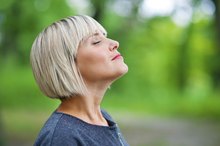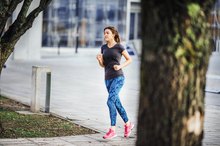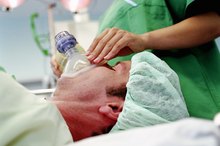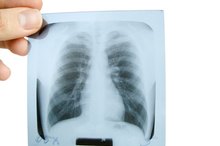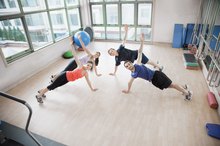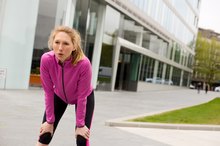The Average Breathing Rate After Exercise
The respiratory system controls your breathing, providing oxygen to your body and eliminating carbon dioxide. Exercise causes muscle movement, increasing carbon dioxide in your body and resulting in an increased respiratory rate -- the frequency of breaths per minute -- to eliminate it from your bloodstream.
Average Resting Respiratory Rate
Normal respiration rate, which we all experience throughout the day, is a passive process controlled by the respiratory system, located in the medulla oblongata of the brain. This normal respiration rate remains constant most the day, but with the initiation of exercise, there is a dramatic change. The resting breathing rate is dependent on age, sex, size, health and lung capacity.
- Normal respiration rate, which we all experience throughout the day, is a passive process controlled by the respiratory system, located in the medulla oblongata of the brain.
- This normal respiration rate remains constant most the day, but with the initiation of exercise, there is a dramatic change.
Average Respiratory Rate During Exercise
How the Heart & Lungs Work During Exercise
Learn More
Respiration rate during exercise depends on several factors, including level of activity, altitude, lung capacity and health. Higher levels of activity and altitudes increase respiration rate. Good health and larger lung capacity typically decrease it. The mechanism at play is the release of epinephrine during exercise, increasing the body's temperature, causing an increased need to breathe more 2.
- Respiration rate during exercise depends on several factors, including level of activity, altitude, lung capacity and health.
- The mechanism at play is the release of epinephrine during exercise, increasing the body's temperature, causing an increased need to breathe more 2.
Breathing Rate Post Exercise
After exercise has stopped, extra oxygen is required to metabolize the built-up lactic acid and to replace any oxygen that has been borrowed from the muscle fibers, air in the lungs and body fluids. To cure this oxygen debt, labored breathing continues after exercise to regain oxygen and to restore homeostasis in the body 2.**
Calculate Your Average Breathing Rate
What Are the Steps of Breathing?
Learn More
Your breathing rate and amount of time it takes to restore the body after exercise depends on the individual and the quantity of carbon dioxide in the blood. Once homeostasis is achieved, breathing rate will return to normal rate. To find your average breathing rate, count the number of breaths you take per minute while resting, exercising and post-exercise five times, then add the numbers together per activity and divide by five to get your average.
Related Articles
References
- "The American Medical Association: Family Medical Guide"; Charles B. Claman, M.D.; 1994.
- "Journal of Theoretical Biology"; Energy Expenditure of Heavy to Severe Exercise and Recovery; C.B. Scott; November 2000
- Della torre V, Badenes R, Corradi F, et al. Acute respiratory distress syndrome in traumatic brain injury: how do we manage it?. J Thorac Dis. 2017;9(12):5368-5381. doi:10.21037/jtd.2017.11.03
- Cretikos MA, Bellomo R, Hillman K, Chen J, Finfer S, Flabouris A. Respiratory rate: the neglected vital sign. Med J Aust. 2008;188(11):657-9. doi:10.5694/j.1326-5377.2008.tb01825.x
- Whited L, Graham D. Abnormal Respirations. StatPearls Publishing. 2019.
- Berliner D, Schneider N, Welte T, Bauersachs J. The Differential Diagnosis of Dyspnea. Dtsch Arztebl Int. 2016;113(49):834-845. doi:10.3238/arztebl.2016.0834
- Hill A, Kelly E, Horswill MS, Watson MO. The effects of awareness and count duration on adult respiratory rate measurements: An experimental study. Journal of Clinical Nursing. 2018. 27(3-4):546-554. doi:10.1111/jocn.13861
- Jafari H, Courtois I, Van den bergh O, Vlaeyen JWS, Van diest I. Pain and respiration: a systematic review. Pain. 2017;158(6):995-1006. doi:10.1097/j.pain.0000000000000865
- Fleming S, Thompson M, Stevens R, et al. Normal ranges of heart rate and respiratory rate in children from birth to 18 years of age: a systematic review of observational studies. Lancet. 2011;377(9770):1011-8. doi:10.1016/S0140-6736(10)62226-X
- Lomauro A, Aliverti A. Sex differences in respiratory function. Breathe (Sheff). 2018;14(2):131-140. doi:10.1183/20734735.000318
- Rudrappa M, Bollu PC. Cheyne Stokes Respirations. StatPearls Publishing. 2019.
- Rodriguez-Molinero A, Narvaiza L, Ruiz J, Galvez-Barron C. Normal respiratory rate and peripheral blood oxygen saturation in the elderly population. Journal of the American Geriatric Society. 2013. 61(12):2238-40. doi:10.1111/jgs.12580
- Subbe CP, Davies RG, Williams E, Rutherford P, Gemmell L. Effect of introducing the Modified Early Warning score on clinical outcomes, cardio-pulmonary arrests and intensive care utilisation in acute medical admissions. Anaesthesia. 2003;58(8):797-802.
- Park S, Khattar D. Tachypnea. StatPearls Publishing. 2019.
- Mochizuki K, Shintani R, Mori K, et al. Importance of respiratory rate for the prediction of clinical deterioration after emergency department discharge: a single-center, case-control study. Acute Med Surg. 2017;4(2):172-178. doi:10.1002/ams2.252
- Flenady T, Dwyer T, Applegarth J. Accurate Respiratory Rates Count: So Should You!. Australas Emergency Nursing Journal. 2017. 20(1):45-47. doi:10.1016/j.aenj.2016.12.003
- Hill A, Kelly E, Horswill MS, Watson MO. The effects of awareness and count duration on adult respiratory rate measurements: An experimental study. Journal of Clinical Nursing. 2018. 27(3-4):546-554. doi:10.1111/jocn.13861
- Li T, Divatia S, McKittick J, et al. A pilot study of respiratory rate derived from a wearable biosensor compared with capnography in emergency department patients. Open Access Emergency Medicine. 2019. 11:103-108. doi: 10.2147/OAEM.S198842
- Mochizuki K, Shintani R, Mori K, et al. Importance of Respiratory Rate for the Prediction of Clinical Deterioration After Emergency Department Discharge: A Single-Center, Case-Control Study. Acute Medicine and Surgery. 2017. 4(2):172-178. doi:10.1002/ams2.252
- O’Leary F, Haven A, Lockie F, Peat J. Defining Normal Ranges and Centiles for Heart and Respiratory Rates in Infants and Children: A Cross-Sectional Study of Patients Attending an Australia Tertiary Hospital Paediatric Emergency Department. Archives of Disease in Childhood. 2015. 100(8):733-7. doi: 10.1136/archdischild-2014-307401
- Rodriguez-Molinero A, Narvaiza L, Ruiz J, Galvez-Barron C. Normal respiratory rate and peripheral blood oxygen saturation in the elderly population. Journal of the American Geriatric Society. 2013. 61(12):2238-40. doi:10.1111/jgs.12580
- Kliegman, Robert M., Bonita Stanton, St Geme III Joseph W., Nina Felice. Schor, Richard E. Behrman, and Waldo E. Nelson. Nelson Textbook of Pediatrics. 20th Edition. Philadelphia, PA: Elsevier, 2015. Print.
- Parkes R.Rate of respiration: the forgotten vital sign. Emergency Nurse. 2011. 19(2):12-7.
Resources
Writer Bio
Dr. Amora Rachelle began her career in journalism at George Washington University in 1994. She is the author of "Health Intelligence," "Journey to Wellness," "Recipes to Wellness" and the blog Reality Therapy. Harvard-trained in mind body medicine, Dr. Amora earned a Ph.D. in health psychology from Albert Einstein Medical School and is presently a Fellow at Hofstra Law in family advocacy.



